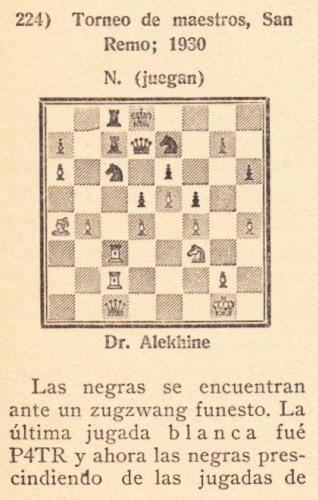
Edward Winter

The above, an example of racial redaction, was shown in C.N. 7875. It comes from page 158 of Combinaciones en el medio juego by Kurt Richter (Buenos Aires, 1947).
C.N. 7875 gave a position from Alekhine v Nimzowitsch, San Remo, 1930, and we should like to know the origins of the term ‘Alekhine’s Gun’, which has been widely applied to a manoeuvre in that game.
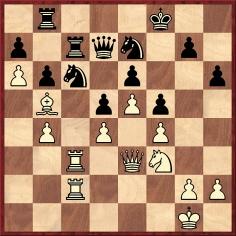
For example, after 26 Qc1 Jeremy Silman wrote on pages 280-281 of How to Reassess Your Chess (Los Angeles, 1993):
‘The pressure White exerts on the file is crushing. After this game was played, this form of tripling on a file with both rooks in the lead became known as Alekhine’s Gun.’
In the periodicals of the time that we have checked, 26 Qc1 received no comment at all. When was the ‘Gun’ term first attached to it?
(7880)
Jeremy Silman (Los Angeles, CA, USA) informs us that he does not recall the provenance of the term ‘Alekhine’s Gun’, which, as mentioned, in C.N. 7880, he used on pages 280-281 of How to Reassess Your Chess (Los Angeles, 1993).
That remains our first sighting of ‘Alekhine’s Gun’ in print. Can readers find earlier occurrences?
(7914)
From Christian Sánchez (Rosario, Argentina):
‘I have found a reference to Alekhine in Russian sources. Fundamentos estratégicos del ajedrez edited by Yakob Estrin (Barcelona, 1985) has the following on page 24, in a chapter by B. Zlotnik (below the relevant diagram):
“Las piezas blancas están idealmente colocadas para penetrar en el campo enemigo. A esa manera de disponer la artillería se le suele dar el nombre de Alekhine, por ser típica del antiguo campeón mundial y sin duda también debido al gran efecto que produjo en una famosa partida jugada en San Remo, en 1930, entre Alekhine y Nimzowitsch.”
The Spanish book comprises only section two of the original work, Теория и практика шахматной игры (Moscow, 1984 [first edition: 1981]), where page 43 has this:
English translation of the marked passage:
“The white pieces are ideally situated for the invasion of the enemy camp. Such an arrangement of the heavy pieces is often called Alekhine’s/Alekhinian, probably on account of the famous game Alekhine v Nimzowitsch (San Remo, 1930).”’
(7972)
Jeremy Silman notes that pages 118-119 of Techniques of Positional Play by V. Bronznik and A. Terekhin (Alkmaar, 2013) discuss Blackburne v Rosenthal, Paris, 1878, in which this position arose:
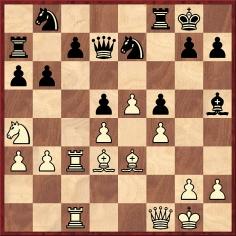
The heading in the book is ‘Brute force: Blackburne’s battering ram’, and the authors comment regarding 23 R1c2 (which was followed by 23...Qd8 24 Qc1):
‘Blackburne brings all three major pieces on to the c-file – and the rooks belong in front of the queen.’
The earliest specimen of the manoeuvre that we can quote is Kennedy v Mayet, London, 1851 (see pages 35-38 of the tournament book):
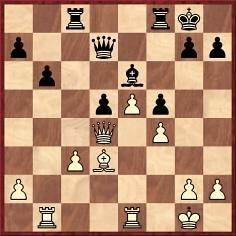
The game continued 21...Rc5 22 a4 Rfc8 23 Rec1 R8c7 24 h3 Qc8.
An earlier game in which the major pieces were tripled, though with the queen placed between the rooks, was Calvi v Kieseritzky, third match-game, Paris, 1842:
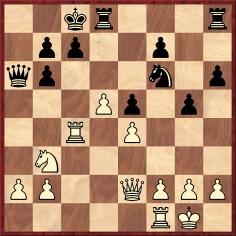
Play went 19 Qc2 Rd7 20 Rc1.
Below is the full score as given on page 39 of Kieseritzky’s book Cinquante parties jouées au Cercle des Echecs et au Café de la Régence (Paris, 1846):
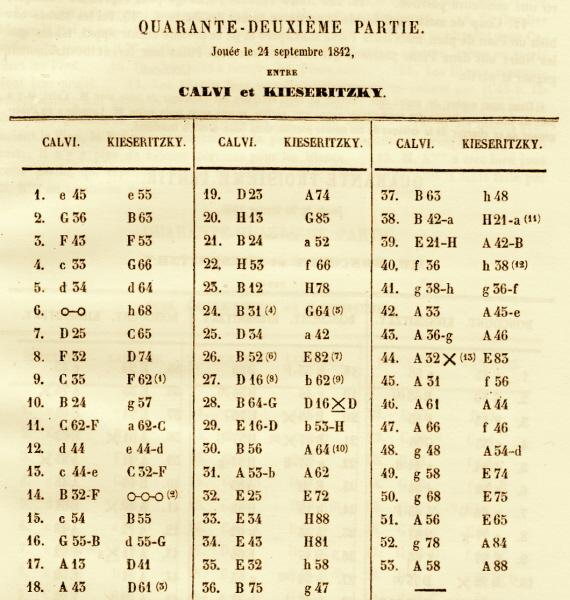
(8625)
Eduardo Bauzá Mercére (New York, NY, USA) sends a game from page B5 of the New-Yorker Staats-Zeitung, 28 January 1923:
Edmund Farago – Jacob Bernstein
New York, January 1923 (Rice Progressive Chess Club Championship
1922-23)
Old Indian Defence
1 d4 Nf6 2 c4 d6 3 Nc3 Bf5 4 e3 Nbd7 5 Bd3 Bg6 6 Bxg6 hxg6 7 Nf3 e5 8 b3 c6 9 Bb2 Qc7 10 Qd3 Be7 11 h3 O-O 12 O-O Rfe8 13 Nd2 Nh7 14 f4 f5 15 Kh1 e4 16 Qe2 Nhf6 17 g4 Kf7 18 g5 Nh7 19 Kg2 Rh8 20 Rh1 Nhf8 21 Nf1 Ne6 22 Ng3 Rh4 23 Qd2 Rah8 24 Nce2 d5 25 Rac1 Qd8 26 c5
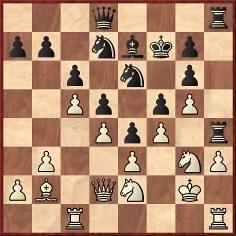
26...R8h7 27 Bc3 Qh8 28 Ng1 Bxg5 29 fxg5 Nxg5 30 Kf1 Nf6 31 Qf2 Nxh3 32 Nxh3 Rxh3 33 Rxh3 Rxh3 34 Rc2 Qh4 35 Be1 Ng4 36 Qf4 Nh2+ 37 Ke2 Qxf4 38 exf4 Nf3 39 Bf2 Kf6 40 Rc1 g5 41 fxg5+ Kxg5 42 Rd1 f4 43 Nxe4+ dxe4 44 d5 cxd5 45 Rxd5+ Kg4 46 Rd7 Ne5 47 Rxg7+ Kf5 48 Rxb7 Rh2 49 c6 e3 50 c7 Rxf2+ 51 Kd1 Rd2+ 52 Kc1 Nd3+ 53 Kb1 Rb2+ 54 Ka1 Rc2 53 White resigns.
(8860)
Eduardo Bauzá Mercére provides the following game:
George Walker – Alexander McDonnell
Occasion?
(Odds of pawn and two moves. Remove Black’s f-pawn.)
1 e4 … 2 d4 Nc6 3 e5 d5 4 c3 Bf5 5 g4 Be4 6 f3 Bxb1 7 Rxb1 e6 8 Bf4 h5 9 Bd3 hxg4 10 Bg6+ Kd7 11 fxg4 Qh4+ 12 Bg3 Qg5 13 Bd3 Nh6 14 Be2 Qe3 15 Kf1 Be7 16 Kg2 Raf8 17 Nh3 Nf7 18 Qd3 Qh6 19 Bf4 Qh4 20 Qg3 Qh7 21 Bd3 g6 22 Rbf1 Bh4 23 Qe3 Be7 24 Rf3 Qg7 25 g5 Rh5 26 Rg3 Qh7 27 Rg4 Bd8 28 Bb5 a6 29 Bxc6+ bxc6 30 Rf1 Be7 31 b4 a5 32 a3 axb4 33 cxb4 Rh8
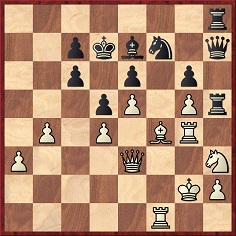
34 Rf3 Nd8 35 Nf2 Nf7 36 h4 Qg8 37 Bg3 R8h7 38 Nd3 Qh8

39 Nc5+ Bxc5 40 bxc5 Qa8 41 Rf6 Rg7 42 Rgf4 Rhh7 43 Qd3 Nh8 44 Rf8 Qb7 45 Rf3 Ke7 46 R8f6 Rg8 47 Kh3 Qb2 48 Qa6 Qb5 49 Qa7 Qb8 50 Qa5 Nf7 51 Kg4 Qb7 52 Qa4 Ra8 53 Qc2 Nh8 54 Rb3 Qa6 55 Qb2 Rg7 56 Rb8 Rg8 57 Rxg8 Rxg8 58 Rf3 Qc8 59 a4 Qa6 60 Qc2 Ra8 61 Ra3 Rf8 62 Rf3 Ra8 63 Ra3 Rf8 64 Qd3 Qa5 65 Qc3 Qa6 66 Qd3 Qa5 67 Qc3 Qa6 68 Qd3 Qa5 69 Ra1 Qb4 70 a5 Qb2 71 Rb1 Qa2 72 Rf1 Rf5 73 a6 Nf7 74 Rxf5 exf5+ 75 Kh3 Qa1 76 Bf2 Nd8 77 Kg2 Ne6 78 Be3 Qa2+ 79 Kg3 Ng7 80 Kf3 Kd7 81 Bf4 Kc8 82 Bg3 Kb8 83 Qe2 Qxe2+ 84 Kxe2 Ka7 85 Bf4 Kxa6 86 Ke3 Kb5 87 Kd3 Ka4 88 Kc3 Ne6 89 Be3 Ka5 90 Bf2 Ka6 91 Kd3 Kb7 92 Ke3 Kc8 93 Bg3 Kd7 94 Bf2 Ng7 95 Kf4 Ke6 96 Bg3 Kd7 97 Ke3 Kc8 98 Bf4 Kd7 99 Ke2 Ke6 100 Bg3 Kd7 101 Kf3 Nh5 102 Bf2 f4 103 Be1 Ke6 104 Kg4 Ke7 105 Bd2 Ng7 106 Be1 Ne6 107 Bf2 Ke8 108 h5 Kf7 109 h6 Kf8 Drawn.
Our correspondent’s source is pages 88-91 of A Selection of Games at Chess ... by William Greenwood Walker (London, 1836).
(12016)
To the Archives
for other feature articles.
Copyright Edward Winter. All rights reserved.